 Soba Canada
Soba Canada (Our logo is designed based on the cross section of the buckwheat kernel.)
 Soba Canada
Soba Canada Soba
and Our Policy
Introduction
(1) "San-Tate" Policy
(2) Business we do
(3) How to eat Soba
(4) Buckwheat as an excellent balanced food
(5) French Paradox
Introduction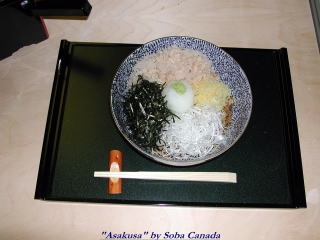
We are the first and only Japanese Buckwheat Noodle (Soba) Restaurant,
Caterer and Retailer/Wholesaler in GTA, Canada who offers a truely authentic
Japanese Fresh Soba Noodle made from the buckwheat cultivated in Garland,
Manitoba, Canada.
A simple word of "Soba" in Japanese means "Buckwheat".
And the noodle made from buckwheat is also called as "Soba".
Soba is delicious with mild flavour and rich aroma.
Those who have eaten Soba before would be able to draw some image of Soba
itself and taste. But we would like to say quite simply that you should
forget about previous image of Soba you might have unless you had it in
a restaurant specializing in hand-made Soba (Teuchi Soba) in Japan. Soba
that you know would be an industrially made dried soba or just hot-water-pouring
instant product without having real taste and flavour of newly cropped
fresh buckwheat itself.
But that's not our type of Soba.
For your guidance, it is defined by old stipulation established in 1968
of "JAS" (Japanese Agriculutural Standard Act) that if the dried
industrial Soba noodle contains buckwheat flour of any grade more than
30% of the total weight, it can be sold in the market with a name of Soba.
Actually most of the dried Soba noodles are made and sold with buckwheat
flour only with 30% or 40% at most because it is technically easy to manufacutre
with a help of gluten of wheat flour which is a main ingredient for it
and also is less expensive not using costly buckwheat flour. So in real
meaning it should be understood as "Udon with buckwheat flavour added".
As a result, you can't expect same health benefits as genuine fresh Soba.
We are a pioneer and only company who serve fresh natural Soba in Canada
in this buckwheat growing country. Ours are fresh and natural hand-made
Soba based upon the safety of the materials we use. It's our wish to contribute
to people's heath and happiness through our truely authentic hand-made
fresh Soba.
![]() Return to the top of this page
Return to the top of this page
(1) "San-Tate" Policy
If you want to eat Soba in its best condition, then you must insist "San-Tate
Soba".
"San-Tate" is a Japanese compound word of San (means 3) and Tate
(a suffix representing the condition of just done). It says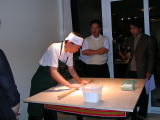 1)"Hiki-Tate" is just having been freshly ground into the
flour"
1)"Hiki-Tate" is just having been freshly ground into the
flour"
2) "Uchi-Tate" is just having been freshly kneaded and
cut into the noodle
3) "Yude-Tate" is just having been freshly boiled and made
it ready for serving.
This "San-Tate" way
of serving Soba gives you soba's best aroma, flavour and texture.
And now we have "Soba Tsuyu" which is the dipping sauce of Shoyu@isoy
bean sauce) mixed with special dashi-broth to dip the "Soba"
in. As the aroma of "Soba" is so delicate, this "Soba Tsuyu"
should not assert itself excessively while maintaining its elegant flavour.
Thus you can enjoy the superb harmony of "Soba" and "Tsuyu".
Basically this "Tsuyu" is made from mainly broth of dried bonito
in a very traditional way but we are also preparing pure Vegetarian "Tsuyu"
separately (need reservation) or you can eat with daikon juice. So complete
vegetarians can enjoy our Soba without any worry. Generally speaking, Japanese
cuisine especially Edo (ancient name of Tokyo) style respects original
natural taste of the materials themselves and always uses the materials
at the height of their season. Happily Japan is surrounded by rich sea
and blessed with high mountains and has distinct four seasons. So every
season brings us various tasty and gorgeous fresh materials from the sea
and the mountain also from the north and the south.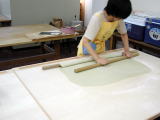 Japanese philosophy is to live with the nature in harmony. Instead of
confronting and /or conquering the nature with power, we try to adapt ouselves
to the order of the universe in which we live as one of the components.
So in our recipe this philosophy also can be seen. Main target of the Japanese
recipe is how to bring out subtle natural flavour, sometimes hidden, from
the material. So Japanese taste at first could be too plain or light for
the majority Canadians who get used to the taste of strong cheese and/or
ketchup. But taste it well for a while and from the next moment it will
surely brings you simple but delicate , deep and profound taste and joy.
Japanese philosophy is to live with the nature in harmony. Instead of
confronting and /or conquering the nature with power, we try to adapt ouselves
to the order of the universe in which we live as one of the components.
So in our recipe this philosophy also can be seen. Main target of the Japanese
recipe is how to bring out subtle natural flavour, sometimes hidden, from
the material. So Japanese taste at first could be too plain or light for
the majority Canadians who get used to the taste of strong cheese and/or
ketchup. But taste it well for a while and from the next moment it will
surely brings you simple but delicate , deep and profound taste and joy.
Most crucial thing in serving Soba to the clients is the speed and the
timing. So real soba eaters know this well and never wait for start eating
when served. Every second you wait, you loose the value proportionately.
It would not be so exaggerated to say that Soba is more delicate and sensitive
than Sashimi (raw fish).
Manitoba has been known as "Buckwheat Capital of Canada" which
has produced more than 70% of Canadian grown buckwheat. It should be free
from any foreign materials like leaves/stems, other grains or stones etc
in order to be ranked as "Canada No. 1" grade with about 15%
moisture content and stored in the grain elevators. As Manitoba is such a cold place in winter, it is perfect
for storage of various grains for a long period of time without suffering
deterioration. With thick insultaion of bins even in summer time inside of the
bins are said to be cold enough.
We use only finest new crops (Canada No.1 grade) of whole buckwheat harvested
in Manitoba in late autumn. We clean it again and sort them out according
to the kernel size. Then vacuum pack it into plastic bags of several sizes.
Thus ready for storage in the freezer for hibernation. Fruits of the buckwheat
even after reaping are still in full energy of germination. To put them
in the hibernation is the best way to keep buckwheat as fresh as possible
avoiding possible deterioration. By this method we can guarantee Shin-soba's
(New Crop's) quality for 365 days a year. So it could be said that our
Soba is "Yon Tate"(Four Tate) adding Tori-Tate (Just Reaped)
on top of San-Tate. Nobody, even a Maestro of Soba, cannot make excellent
soba without using good buckwheat. It is said that 80% of soba's taste
is determined by buckwheat's quality itself and only rest of 20% is subject
to the various techniques of the Maestro though a bit too modest I feel.
But it tells clearly how good buckwheat and its proper storage is so important.
Flour is different from whole buckwheat protected by its thick epicarp.
Once you grind them into flour, most of the flavour/aroma will be lost
surprisingly quick. Some study says that 50% of its volatiles such as Ethylbenzene
and Xylene etc disappear within 15 minutes after grinding. And further
15 minutes are enough to loose another 20% of volatiles . So within 30
minutes, 70% of total flavour/aroma substances are dissipated. Thereafter
change is said to be slow but 24 hours seemed to be enough to loose nearly
all. It is possible to delay or stop the disappearance of volatiles by
storing it in tightly closed container or vacuum packed in freezer, but
it is indeed very difficult and costly to keep such condition well. It
is our surprise to know such a delicate trait of buckwheat flour. So quality
of flour is totally depending upon the good and quick care of the flour
just after grinding. Flour sold in poor packaging like paper bag etc and
stored in high ambient temperature cannot be maintained its original quality
for a required shelf life.
Now you know the reason why we stick to "Hiki-Tate" just freshly
ground flour only. For that pourpose we make our freshly ground Soba flour
every morning by ourselves using stone mills imported from Japan only for
the quantity required for a use of the day. There are several types of
mill. For most millers they use high speed roll-milling machines with normally
around 300 rpm. This machine is very efficient and high yielding but due
to its mechanism and high speed, flour is tend to be burned dry and loose
aroma/flavour with discoloration. So we use stone mills for best flour
quality dispite of its low productivity. We operate our mills as slow as
16 rpm in order to avoid any heat damage. And different from the roll milling
machine, the process of stone mill is not only to grind buckwheat into
pieces but more importantly is its kneading function which cannot be expected
in any other machines. Furthermore slow grinding doesn't overly destroy
the cells which contain various nutritions, consequently it can give you
good texture and flavour. Thus only the flour made from stone mill with
the professional care is the perfect much for hand-making Soba (Teuchi
Soba) with its comfortably moist and gentle quality keeping its original
trait. Immediately after having had fresh flour, Soba is made following
to the most traditional Edo-Tokyo style method and boiled with proficiency.
You will find new world there. We do everything by ourselves from A to
Z including milling. We have various types of soba depending upon the flour
ground. From a thick and blackish "Inaka Soba" ( Country style)
with rich taste and flavour to a refined thin and more whitier "Edo"
style Soba with aroma . So please tell us which type of soba you like after
trying our varieties of fresh Soba. You will be quite surprised by the
difference what you have known as Soba before.
In conclusion, the key for serving Soba is simple. Good care of the buckwheat
through the year round and control the timing of serving based upon clients'
situation. Only fine management on both hard and software can achieve this
goal. This is just a common theory for all businesses. We do just the right
thing in right timing. That's the Soba Canada.
Only Soba Canada offers
"San-Tate Soba" (or Yon-Tate Soba) in Canada for Canadians using buckwheat
harvested in Canada.![]()
![]() Return to the
top of this page
Return to the
top of this page
(2) Business we do
1) Soba Restaurant
We operate "Soba Night on Tuesday" at Ichiriki Restaurant
which is one of the best Japanese Restaurants in Canada. Open on every Tuesday from 17:30 to 20:30 / Urikire -Gomen (could be closed earlier in case of having been sold-out).
Location is in downtown Toronto at 120 Bloor Street East, Toronto (1 or
2 minutes east of Yonge/Bloor, next to HBC/Mariott, 1st floor of the building
on Bloor St. north side). Come and try our popular TenZaru or Kani Hiyagake
(Snow Crab from Atlantic) ... Of course, there are much
more but except Sushi.
Reservation is recommended. Please call Ted to 416-436-7997.
2) Soba classes (Soba-Uchi-KyoushitsuΌΕΏ³Ί)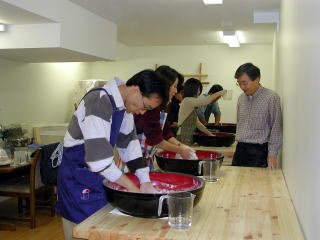 or learning traditional Edo-Tokyo Style hand-making skills
or learning traditional Edo-Tokyo Style hand-making skills
The taste of "Soba" is totally depending upon how excellent Sobako
Ό²(Flour) you can use. So even a Maestro can not make delicious Soba using
bad sobako. As far as you are using our boastful Sobako which we stone-mill
every morning, even if you are a fledgling of Soba making, you can beat
a Maestro with bad sobako. Sobako is so crucial in making "Soba".
It may seem to be very difficult to hand-make the "Soba" but
it actually is far easier than what you would be feeling. Of course to
be a Maestro is so difficult, but to acquire the basic technique for hand-making
"Soba" is not so difficult. Our method is traditional Edo-Tokyo
Style. Edo-Tokyo Style is the most advanced and refined style of hand -making
Soba in Japan. Because its pourpose is to make beautiful Soba as a merchandise
for selling while other country styles are for self-consumption. So the
taste, flavour, texture and the appearance is in the state of the art with
standard width of the Edo style Soba is only 1.3mm while other country-styles
are ranging from 2.0 to 3.5mm with darker color. This knife work of Edo's
standard width is expressed as "Kiribera 23 bon" which means
23 cuts for 1 sun (=3.03cm).
Thus you can give a pleasant surprise to your family and friends serving
your own hand-made "Soba" at home. I guarantee the taste because
you are USING MY FRESHLY GROUND FLOUR from new crop of No.1 Canada grade
buckwheat with the best care. It's no comparison to the instant or dried
one.
We provide several classes according to your requirements. The classes
are basically private so you can set up your convenient schedule and location
at Mississauga but can be arranged anywhere with costs.
"One Day Experience Class" : $80.00+tax/person
For those who don't know anything about Soba making but an
interest, this class would be the suitable one. We will demonstrate
first, then you do it by yourself. You will make about 5 portions of Soba
and take your hand-made soba back to your home. It normally
takes 30 minutes for demonstration with eplanation and 1 - 2 hours for
Soba-making. Bring your apron and a container to take Soba back home.
"The Beginners Class" : $375.00+tax/person
This is 5 days course to acquire the basic skills of Soba-Uchi and you
could make your own soba without asking any help to the others at the end
of the course.
You will make practices with 500g size which is about 5-6 portions. Please
bring your notebook/apron/towel and container.
"The Intermediate Class" :
After completing the Beginners Class, to acquire the refined skills of
Soba-Uchi together with basic knowledge about Soba/Buckwheat. You will
make practices 7 days with bigger batch (1 - 1.5kgs) which will be the
ideal size for quality and practical point of view. Popular NiHachi Soba
would be your favourite repertoire. Please bring the notebook/apron/towel
and container.
"The Professional Class"
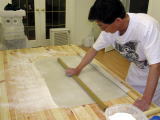 This class is for those who have a passion on Soba and want to be a professional
or to open up their own Soba Restaurant. The class consists from 20 days
learning session together with lectures. You will study about Soba/buckwheat
from various aspects. The schedule for the class will be upon consultation.
Prices and other details available upon request. You will know all about
Soba including milling technique at the end and can start creating your
own style of Soba according to your philosophy.
This class is for those who have a passion on Soba and want to be a professional
or to open up their own Soba Restaurant. The class consists from 20 days
learning session together with lectures. You will study about Soba/buckwheat
from various aspects. The schedule for the class will be upon consultation.
Prices and other details available upon request. You will know all about
Soba including milling technique at the end and can start creating your
own style of Soba according to your philosophy.
"Maintenance Class"
After finishing above classes you may feel the necessisty to come back
sometimes to our Kyoushitsu in order to maintain or brush up your acquired
Soba-Uchi skills. You can use all necessary equipment and facility. Please
call for the reservation.
3) "Shyucchou Teuchi Soba"
(Catering service of hand-made Soba) with on the spot performance (Soba-Uchi).
We do catering to anywhere with necessary equipments for corporation's
events or private parties in some special occaisions in any size based
upon reservation. In Japan, "Demae" (Catering) in the past was
popular sytle of Soba delivery to your home or office and still is in certain
area. But Soba dishes cannot maintain its best condition for eating after
elapse of certain time for delivery to your home and it is surely exhausted
out by loosing texture.
As our policy is to serve "San-Tate" soba which we discussed
before, we definitely prefer to prepare and serve our Soba just on the
spot of your special occasion in order to avoid offering remains of Soba-like-noodle.
Upon having received your reservation, we will make contact with you for
details what type of soba you would like to have and visit your designated
place with necessary materials and equipments. We will demonstrate our
performance Soba-Uchi in front of you first then start serving. It's fun
and price is reasonable. Please ask for prices etc.
4) Retail/Wholesale and Export & Import
*Flour, Groats and Grits
Sale of freshly ground Sobako (Flour) in 500g/1kg vacuum pack,
whole buckwheat with epicarp and/or de-hulled natural buckwheat
(Maru-nuki or groats) together with other Soba/Health related goods. In
case of Sobako, we may be able to comply to your request about
spec of your own Sobako upon reservation. Tell us spec for your special
soba.
*Organic creamy natural soy milk & Nigari coagulant (sea water extract)
Soy Milk dense enough to make nice
*Fresh Soba
With minimum quantity of 5 portions with Tsuyu (dipping sauce).
It will be helpful to have your order at least one day before
the delivery.
*Premium Buckwheat Honey
Made from our buckwheat field in Manitoba. It comes by 1kg pack with $15.50. Buckwheat Honey is the darkest in color amongst all honeys and have unique scent and this flavour brings us the strongest health benefits. At my
home we are replacing sugar to this buckwheat honey for a cup of
coffee and enjoying toast with plenty buckwheat honey and also
to all needs for cooking.
*Export of Buckwheat (whole or flour) and import of soba uchi(soba making)
equipments.
5) Consultancy
Business consultation for opening your own restaurant or to
re-float your spoilt business or for trading? We can help you
for planning at any stage. Have you read our "Whey do we SOBA? Our
basic way of thinking"? Not only restaurant business but
any kind of business in North America that wishes to be a really nice company
which earns not only money but also respect is
welcome. We will help you how to make a bridge with your customors based
upon true appreciation by Japanese traditional mind to think harmony internally
and externally. @ ![]() Return to the top of this page
Return to the top of this page
(3)How to eat Soba
It may be necessary to tell you how to eat soba. As the soba is a food backed up by a long history and tradition, sophisticated Edokko (people who live in Tokyo formerly called Edo) manners have been established. One of typical sophisticated way of eating Zaru or Seiro Soba (cold noodle) is as follows though there could be many other ways.
But one very important thing I want you to know is that Soba like other
Japanese traditional cuisine is very simple and delicate. Japanese philosophy
of cuisine is to respect and pay full attention to the original flavour
of the materials we use. Sauce and garnishes etc. should be modest enough
not to spoil the taste and flavour of the materials. In case of Soba, the
taste and aroma of buckwheat is subtle and soft. So in order to taste and
enjoy such gentle and delicate flavour of the material, you should tune
up your tongue by fresh water before eating. It is recommended not to eat
fatty, strong foods which might spoil your gustatory bud. Keeping away
from junk foods preferably for one or two weeks, you could be ready for
enjoying delicate foods with refreshed taste buds. It was said in the past
that Canadians' favourite eating style could be described as "2B"
which stands for Big and Bold. But as the society is getting old with baby
boomers, this style is gradually being replaced by the words "Clearer",
"Simpler" and "Flavourer" that mean the change from
the Volume to the Quality (Authenticity). The Freshness is a key word in
the era of Authentic Flavour and it would involve the idea of @Protect
Health AImprove Health BFreshly Made. That is our Teuchi Soba.
1) First of all pick up several lines of soba and eat it as it is in order
to feel soba's own taste and aroma.
@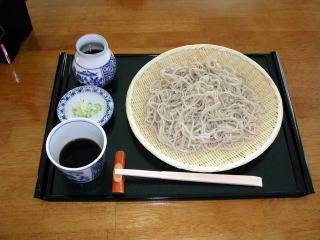 2j Then pour Tsuyu a little bit into a Soba-choko(Soba bowl) and hold up
a Soba-choko and pick up reasonable (smaller) amount of soba which may
depend upon the size of your mouth, then dip it to the "Tsuyu"
by still holding soba in the air with your chopsticks but only half way
down. Don't soak the soba entirely to Tsuyu. And enjoy this simple combination
of Soba and Tsuyu for a while.
2j Then pour Tsuyu a little bit into a Soba-choko(Soba bowl) and hold up
a Soba-choko and pick up reasonable (smaller) amount of soba which may
depend upon the size of your mouth, then dip it to the "Tsuyu"
by still holding soba in the air with your chopsticks but only half way
down. Don't soak the soba entirely to Tsuyu. And enjoy this simple combination
of Soba and Tsuyu for a while.
We have various "Tsuyu" depending upon the dish and in case of
Zaru Soba Tsuyu is very thick and strong(especialy Edo-Tokyo style) and
not designed for soaking.
3) Thereafter put elegant portion of condiments such as Negi(minced long
onion) into Soba-Choko and put wasabi on top of Soba (Japanese horseradish)
then dip reasonable portion of Soba same as step-2. Thus you can enjoy
different taste with just one plate.
4)Suck soba with the slight sound of the air. I know slurping is deemed
to be most rude according to the Western style table manner. It's basically
the same in Japan. However in certain ocasion there are exceptions and
in case of Soba this modest slurping is considered stylish/cool () especially eaten by good looking men and women. It's sophisticated and
trendy and never be rude. (For women even in recent Japan, it is observed
less slurping than men because of general concept of slurping as vulgar
under the influence of western culture. But only in case of noodle eating
it is allowed and considered as smart.
Of course it is not necessary to be wedded to this fashionable eating style
and it's all upto you to eat at your own comfortable style. The world is
changing and new culture always comes into bud in this way.)
5)At the end of eating Soba, pour Soba-Yu (Hot Soba Water) into the Tsuyu
and drink. This Soba-Yu is fully nourishing and will sum up your soba eating
of the day. Please enjoy.
![]() Return to the top of this page
Return to the top of this page
(4) Buckwheat as an excellent balanced food
Japan has a long history of buckwheat growing. Mainly in eastern Japan,
buckwheat plant opal / pollens were found in more than 10 ruins of mid/late
Jomon era (BC6,400 - 3,000) which proved slash-and-burn method of agriculture
were there and they also cultivated millet, adzuki beans, soy beans etc
and rice too even before rice cultivation was conveyed from the continent
(It was in Yayoi era BC600 - AD300 according to former theory.)
First official record appeared in "Shoku Nihongi" ±ϊ{Ithat Empress Gensho decreed to grow more buckwheat preparing for the famine(AD722 Nara era). As buckwheat grows very fast only with 75/90 days and in case of other farm produces were expected to be poor, it could lessen the impact of such crop failure with its fast growing character together with balanced nutrients which is superior to other grains.
Strong points of buckwheat are so many and because of the efficacy more
truth will be revealed by many studies ;
1. Protein content is high especially rich with Lysine (700mg/100g)
and its amino acid score (quality) 93 is one of the best in comparison
with other grains and it's gluten free.
2. Vitamins especially vitamin B1 & B2 are rich
3. Minerals such as potassium, magnesium etc are rich
4. Dietary fibres are rich especially hemicellulose
5. Polyphenols for anti-oxidization effect etc such as Rutin , Catechin,
Proanthocyanisine, Quercetin and Vitexin etc are rich. Recently there are
many studies on buckwheat mainly for functional roles of polyphenols and
dietary fibres, so much more benefits of buckwheat will be revealed shortly.
As you can see that buckwheat is blessed with high quality protein combined
with vitamins, minerals, fibres and polyphenols especially rutin. These
useful substances are to work alone or together in synergy and also the
way of cooking/eating is further enhancing its miracle power. All of these
factors adjust body functions and enhance immunity of our body. Buckwheat
is especially good for cardio-vascular / capillery vessels function anything
that flow in the body.
One more thing we would like to emphasize is the fact that buckwheat is just a minor produce and never be like big brothers wheat or corn. In Canada even in the official statistics, buckwheat is classified as one of "special crops".
It may sound pity but on the other hand it's lucky to have such minor status
in the modern world. Because of the small money value of the buckwheat,
no big capitals show the interest for so called "breed inprovement"
by GM (genetic modification) so far. Huge research and development costs
would'nt justify as a tool of a money making business. So buckwheat has
been maintaining its original,wild, strong and healthy trait even upto
now. For a plant what is the pourpose of having seeds? It's the constant
struggle for a survival enduring to the severe environment and leave their
genes for the future. And only seeds that endured and adapted themselves
to this environmental stress could survive. That is called the evolution
or the natural selection. So endured buckwheat is strong and healthy and
in one inconvenience for human is its "infinite inflorenscence"³ΐΤ. Different from wheat or rice, buckwheat grows leaves simultaneously with
flowers infinitely. That means flowers/seeds in different stages grow simultaneously
on the same stem and when the youngest set started grow, first set started
falling on the ground as a ripe seeds.In this way buckwheat can leave their
genes for the future regardless of any hostile environmnet but inconvenience
to human for effective harvesting. As study trains human, environmnet stress
together with commercially handicapped these traits trains buckwheat and
make it safe, strong and healthy.
Buckwheat is under-appreciated now despite of superior trait but we have
to know buckwheat better for our safe and healthy future too.
Please also see Soba and Health for the detailed ingredients of buckwheat and their efficacies.....
![]() Return to the top of this page
Return to the top of this page
(5)French Paradox
 As discussed above (1) "San-Tate Policy", Manitoba has been
known as Buckwheat capital of Canada and producing more than 70% of total
Canadian buckwheat. In 2004 canada was ranked as 11th country of world
buckwheat producing countries with 10,000K/T while Japan produced 26,800K/T
with 8th ranking. Thereafter production was getting smaller year by year.
It was very regrettable to note such declining tendency of Canadian production
due to bad weather and/or market change in recent years. But we hoped whole
situation could be changed and production would pick up again in short
future because of the introduction of the new variety of self-polination
etc. We were eagerly expecting such improvement.
As discussed above (1) "San-Tate Policy", Manitoba has been
known as Buckwheat capital of Canada and producing more than 70% of total
Canadian buckwheat. In 2004 canada was ranked as 11th country of world
buckwheat producing countries with 10,000K/T while Japan produced 26,800K/T
with 8th ranking. Thereafter production was getting smaller year by year.
It was very regrettable to note such declining tendency of Canadian production
due to bad weather and/or market change in recent years. But we hoped whole
situation could be changed and production would pick up again in short
future because of the introduction of the new variety of self-polination
etc. We were eagerly expecting such improvement.
((In 2005 world first self-polinated variety called "Koma" appeared
and took the mojority share for export to Japan. But several years later,
there was big turbulence in the Canadian buckwheat industry and it virtually
collapsed .....)
Though we still have considerable amount of buckwheat for local supply,
it is very difficult to buy buckwheat (whole and/or flour or kasha) locally
at supermarkets and it is impossible to enjoy authentic fresh Soba because
no one is serving such noodle. 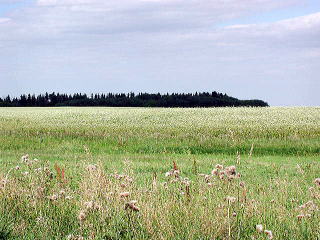 This is the really regrettable situation for Soba lover like myself. It
reminded me of a famous Canadian Paradox. ie, Space and Silence, Abundance
and Emptiness.
This is the really regrettable situation for Soba lover like myself. It
reminded me of a famous Canadian Paradox. ie, Space and Silence, Abundance
and Emptiness.
Despite of the abundance of buckwheat, Emptiness prevails in the Canadian
market. If this is an act of God, I don't complain. But this is just a
matter of human life style. Good thing have to be adopted and should be
able to enjoy the life with more satisfaction. I want to eat authentic
Soba everyday and to enjoy the life keeping good health eating nutritious
and delicious Soba. Soba has a great possibility to contribute to our health
at this modern world facing with the aging problem. And its easy digestion
doesn't give any load to the stomach and its well balanced nutritious composition
is ideal for the peoples in all ages ie, for the babies and children at the growth period and/or for pregnant
women and of course for the seniors. In Japan since long time ago, monks
who lead ascetic life in the mountain took only plants and vegetable. But
in their practice of most severest asceticism, they highly relied on the
buckwheat as their lifeline. Because it can be eaten as it is (raw) due
to its digestive nature and well balanced nutritious ingredients will instantly
give energy. To overcome the Canadian Paradox is the simple reason of my
starting this business.
Have you ever heard another Paradox? This paradox became famous from a
TV show broadcasted a decade ago. In France they eat lot of cheese, buttery
sauces and other rich foods but suffer less heart disease than North Americans.
Why? Recent newspaper says some Institute at the London School of Medicine
found that "Polyphenols" contained in red wine decrease the endothelin-1
level which is a potent blood vessel constrictor and overproduction of
the compound is considered a key reason why arteries clog with fatty deposits.
Yes, the secret was "Polyphenols" contained in red wine (mainly
proanthosyanisine). There are many studies on "Polyphenols" and
still undergoing. University of Victor Segalen in Bordeaux, France seems
to be a center of such study in France. Polyphenols have remarkable biological
properties and help prevent, delay and even cure a number of diseases including
cancer , AIDS and type2 diabetes etc. And furthermore it will rejuvenate
your body together with skin. Marie Antoinette washed her face in red wine
to protect against wrinkles.  It is an antioxidant components which includes flavonoids, anthocyamins
and certain tannins and considered the most efficient active ingredient
to neutralize free radicals which are damaging chemicals intermediates
in the body. The recent study on Buckwheat also revealed this amazing Polyphenols
called "Rutin" is rich in Buckwheat too. That's why "Soba"
eaters in Japan enjoy longevity with good health. However even if "Red
wine" is said to be good for the health, we should not forget that
it is the matter of balance. It is also true that French ratio dying by
stomack or liver disease is much much higher than other Erupeans/North
Americans. Thus lowering their average life span than others. Over drinking
of their Wine will be the main reason of this tendency. So we should know
that relying upon only one thing or over intake will not contribute to
our health and may even affect adversely because the universe is standing
on the balance.
It is an antioxidant components which includes flavonoids, anthocyamins
and certain tannins and considered the most efficient active ingredient
to neutralize free radicals which are damaging chemicals intermediates
in the body. The recent study on Buckwheat also revealed this amazing Polyphenols
called "Rutin" is rich in Buckwheat too. That's why "Soba"
eaters in Japan enjoy longevity with good health. However even if "Red
wine" is said to be good for the health, we should not forget that
it is the matter of balance. It is also true that French ratio dying by
stomack or liver disease is much much higher than other Erupeans/North
Americans. Thus lowering their average life span than others. Over drinking
of their Wine will be the main reason of this tendency. So we should know
that relying upon only one thing or over intake will not contribute to
our health and may even affect adversely because the universe is standing
on the balance.
![]() Return to the top of this page
Return to the top of this page
![]() Return
to the Index Page
Return
to the Index Page
About buckwheat (Soba), Soba & Health/Safety of foods, Japan Nowadays, Various Recipes of Buckwheat, Contact Us, Links to other site